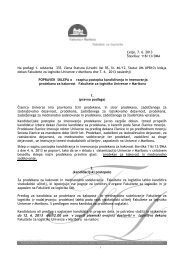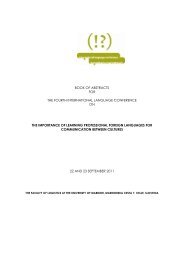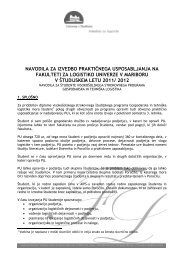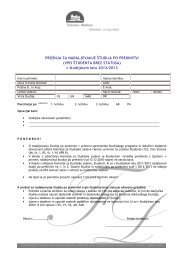cultural dimensions and patterns
cultural dimensions and patterns
cultural dimensions and patterns
- No tags were found...
You also want an ePaper? Increase the reach of your titles
YUMPU automatically turns print PDFs into web optimized ePapers that Google loves.
Methods of Teaching Inter<strong>cultural</strong>Business Negotiation to Students ofBusiness <strong>and</strong> EconomicsMárta Dévényi
Methods of Teaching Inter<strong>cultural</strong> BusinessNegotiation to Students of Business <strong>and</strong> EconomicsThis paper focuses on the function of <strong>cultural</strong> <strong>dimensions</strong> <strong>and</strong> <strong>patterns</strong> inanalyzing <strong>and</strong> comparing cultures to underst<strong>and</strong> their differences <strong>and</strong>similarities.• The <strong>cultural</strong> <strong>dimensions</strong> of Geert Hofstede• The aspects of communication <strong>and</strong> culture identified by Edward T.Hall• The <strong>cultural</strong> <strong>patterns</strong> described by Richard Gestel<strong>and</strong>
The components of <strong>cultural</strong> intelligence <strong>and</strong> inter<strong>cultural</strong>competence required in inter<strong>cultural</strong> negotiationsCULTURAL INTELLIGENCECognitive component: the ability to underst<strong>and</strong> <strong>and</strong> make sense of <strong>cultural</strong> cues aswell as to develop new <strong>cultural</strong> schemasMotivational component: the drive <strong>and</strong> the motivational force to adapt to the new<strong>cultural</strong> environmentBehavioural component: the ability to enact <strong>cultural</strong>ly appropriate behaviourINTERCULTURAL COMPETENCETan <strong>and</strong> Chu, 2003• communication skills• tolerance for ambiguity, empathy, open-mindedness, flexibility• ability to adopt a dual focus: focus on both task <strong>and</strong> relationship, positiveattitude to learning• <strong>cultural</strong> knowledge, tolerance for different styles <strong>and</strong> cultures, ability tosucceed in multiple <strong>and</strong> diverse environmentsTan <strong>and</strong> Chu, 2003
Guideliness to culture <strong>and</strong> communication• Cultural knowledgeis the basis of underst<strong>and</strong>ing <strong>and</strong> making sense of <strong>cultural</strong> cues <strong>and</strong>developing new <strong>cultural</strong> schemas (the cognitive component of <strong>cultural</strong>intelligence)• The <strong>cultural</strong> knowledge of business professionalscan be supported by using <strong>cultural</strong> <strong>dimensions</strong> <strong>and</strong> <strong>patterns</strong> inanalyzing diversities <strong>and</strong> similarities in cultures <strong>and</strong> business cultures.
Hofstede’s Cultural DimensionsValues differ mainly along four <strong>dimensions</strong>:• Power Distance• Individualism versus Collectivism• Masculinity versus Femininity• Uncertainty Avoidance versus Uncertainty AcceptanceThe behaviour <strong>and</strong> negotiating style of negotiators in internationalnegotiations are influenced by their• national, professional <strong>and</strong> organisational culture• personal skills <strong>and</strong> characterNegotiators should “share the national culture <strong>and</strong> values of the countrythey represent, because, otherwise, they will not be trusted by theirown side” Hofstede, 1991
Some presupposed consequences of related <strong>cultural</strong><strong>dimensions</strong>Large Power Distance• centralised control <strong>and</strong> decision-making during the negotiationprocess.Collectivist cultures• need stable relationships with their negotiating parties• the replacement of negotiators should be avoided• mediators <strong>and</strong> go-betweens play an important role• formal harmony is requiredMasculine cultures• sympathy for the strong• ego-boosting behaviourFeminine cultures• ego-effacing behaviour• sympathy for the weakUncertainty Avoidance• low tolerance of ambiguity• distrust of opponents
Hofstede’s Cultural Dimensions• If negotiators are aware of the approximate position of their (<strong>and</strong>the other party/parties’) national culture’s value system in terms of<strong>cultural</strong> <strong>dimensions</strong>, they can predict significant aspects of theirforthcoming negotiations in an inter<strong>cultural</strong> environment.• To be able to decode the other party/parties’ communication <strong>and</strong>interpret their behaviour, negotiators should acquire “an insight intotheir own <strong>cultural</strong> values <strong>and</strong> the extent to which these deviatefrom those of the other side(s)”Hofstede <strong>and</strong> Usunier, 1996
Hall’s Aspect of Communication: High <strong>and</strong> LowContext Communication• Hall considers the level of context we use as the basis determiningcommunication <strong>and</strong> behaviour.• He says that two entirely different but highly interrelated processesmake contexting possible:– internal contexting comprises the past experience (internalcontext) of the speakers.– external contexting comprises the situation <strong>and</strong>/or setting inwhich an event occurs (external: situational <strong>and</strong>/or environmentalcontex)• The components of the internal <strong>and</strong> external context of communicationcan be used as communicational devices - but different nations usethem at different rates.
Hall’s Aspect of Communication: High <strong>and</strong> LowContext CommunicationThe level of context determines communication:LC communication• it is the code which transmits most of the information• its message is verbally coded• explicit• direct communicationHC communication• the context has more important role• much information is transmitted non-verbally• only a small part of the message is verbally coded <strong>and</strong> explicit• the rest being implicitly in the context• indirect communication
Hall’s Aspect of Communication: High <strong>and</strong> LowContext Communication• Low-context communicationWestern <strong>and</strong> Central Europe is toward the lower end of thescale• High-context communicationSouthern Europe is at the higher end.German <strong>and</strong> Swiss-German is the lowest-context <strong>and</strong> Japanese is thehighest context of all.There are no extreme differences regarding the use of context inEuropean business negotiations.To ‘ascertain the correct level of contexting’ might happen unconsciouslywithin one’s culture, but the appropriate amount of context to usebetween cultures can be determined only consciously.
Hall’s Aspects of Culture: Orientation to TimePeople belonging to different cultures h<strong>and</strong>le time in different ways• rooted in their <strong>cultural</strong> tradition <strong>and</strong> social settingMonochronic (M-time)• doing one thing at a time• events scheduled as different items• North European modelPolychronic (P-time)• doing many things at a time• involvement in several things at once• the Mediterranean model
M-timeHall’s Aspects of Culture: Orientation to Time• being tangible• methaphores:”being saved, spent, wasted, lost, made up, crawling,killed <strong>and</strong> running out” [6].• M-time is learnt as the logical way of organizing life.P-time• world is dominated by human relationship• tight scheduling is impossibleDifficulties for business professionals in an inter<strong>cultural</strong> context”The two systems are logically <strong>and</strong> empirically quite distinct.Like oil <strong>and</strong> water, they don’t mix” Hall, 1991Japan: incorporating both polychronic <strong>and</strong> monochronic functionsadaptation to the dominant time system of the world
Richard Gestel<strong>and</strong>’s Cultural PatternsDeal-Focused vs. Relationship-Focused cultures• DF people are task-oriented• RF people are people–oriented in business relations• DF people use direct, frank, straightforward language• RF people use indirect language in a subtle, roundabout styleThis pattern of diversities in communication <strong>and</strong> behavior has itsroots in Hall’s low-context vs. high-context aspect ofcommunication.Informal vs. Formal Cultures• informal vs. formal behaviour• dependent on different rates of equality in societies:small differences in status <strong>and</strong> power vs.steep hierarchies, major differences in status <strong>and</strong> powerThis pattern has its roots in Hofstede’s high vs. low PowerDistance dimension.
Richard Gestel<strong>and</strong>’s Cultural PatternsRigid-time vs. Fluid-time Cultures• refer to the same type of cultures as Hall’s monochronic vs.polychronic systems of life:• punctuality, schedules, fixed agendas <strong>and</strong> deadlines vs.• flexible agendas, loose scheduling, doing more than one thingsimultaneously.Expressive vs. Reserved Cultures• based on the behavior <strong>and</strong> verbal, paraverbal <strong>and</strong> nonverbalcommunication• Expressive Culturesconversational overlaps <strong>and</strong> intense or firm eye contact• Reserved Culturesconversational turntaking <strong>and</strong> moderate or indirect eye contact
Richard Gestel<strong>and</strong>’s Cultural Patterns• Gestel<strong>and</strong> characterizes his book”as a practical guide for the men <strong>and</strong> women in the front lines ofworld trade, those, who face every day the frustrating differences inglobal business customs <strong>and</strong> practices”• Gestel<strong>and</strong>’s <strong>patterns</strong> of culture categorise <strong>cultural</strong> variables in asimple way, which is why they are easy to use by businessprofessionals in business interactions <strong>and</strong> negotiations.
ConclusionTeaching Business Negotiation with an inter<strong>cultural</strong> perspective forstudents of Business <strong>and</strong> Economics is a multi-purpose task:• practice-oriented negotiation theory• negotiating practice: simulating business negotiations• <strong>cultural</strong> knowledge:characteristics of one’s own culture <strong>and</strong> those of other culturesnational, professional <strong>and</strong> organisational elementsIt is impossible to possess all of the relevant information about allcultures in the major inter<strong>cultural</strong> settings of business encounters.It is <strong>cultural</strong> <strong>dimensions</strong> <strong>and</strong> <strong>patterns</strong> which provide the relevant meansto compare <strong>and</strong> analyse diversities <strong>and</strong> similarities in the case ofdistinct cultures.
ConclusionIf someone has acquired the knowledge <strong>and</strong> skills needed to use <strong>cultural</strong><strong>dimensions</strong> <strong>and</strong> <strong>patterns</strong>,he has the ability to select the relevant information concerning theculture which he encounters in inter<strong>cultural</strong> business negotiations.Thus this is why it is important to involve <strong>cultural</strong> <strong>dimensions</strong> <strong>and</strong><strong>patterns</strong> in the syllabus of Inter<strong>cultural</strong> Business Negotiation.This paper focuses on the <strong>cultural</strong> <strong>dimensions</strong> of Hofstede, the <strong>patterns</strong>of communication <strong>and</strong> culture identified by Hall <strong>and</strong> the <strong>cultural</strong><strong>patterns</strong> described by Gestel<strong>and</strong> for the simple reason that in theauthor’s teaching practice these were found the most adequatemeans for developing students’ inter<strong>cultural</strong> competence.
Conclusion• Misusing <strong>cultural</strong> <strong>dimensions</strong> <strong>and</strong> <strong>patterns</strong> in dealing with culturesmight lead to stereotyping.• Using them consciously <strong>and</strong> trying to find the interrelated <strong>dimensions</strong>of <strong>cultural</strong> <strong>dimensions</strong> <strong>and</strong> <strong>patterns</strong> in respect of distinct cultureswill help us to avoid drawing stereotypical conclusions.• Further we should never forget that all encounters in inter<strong>cultural</strong>business negotiations are unique,• since they are based on the skills <strong>and</strong> personality of individualnegotiators,• the <strong>cultural</strong> components which they possess <strong>and</strong> the relevant• professional, organisational <strong>and</strong> social settings in whichthe negotiations are proceeding.
REFERENCES[1] J-S. Tan <strong>and</strong> R. Y-J. Chua, “Training <strong>and</strong> Developing CulturalIntelligence,” In: Cultural Intelligence, P. C. Earley <strong>and</strong> S. Ang Eds. Stanford:Stanford University Press, 2003, pp. 258-303.[2] G. Hofstede <strong>and</strong> J-C. Usunier, “Hofstede’s Dimensions of Culture <strong>and</strong> theirInfluence on International Business Negotiations,”In:International BusinessNegotiations, P. N. Ghauri <strong>and</strong> J. Usunier, Eds. Oxford: Elsevier Science Ltd,1996, pp. 119-126.[3] G. Hofstede, Cultures <strong>and</strong> Organizations, London: Harper CollinsPublishers, 1991, pp. 3-258.[4] E. T. Hall, Beyond Culture, New York: Doubleday, 1990, pp. 85-103.[5] E. T. Hall, The Dance of Life, New York: Doubleday, 1990, pp. 59-77.[6] E. T. Hall, The Dance of Life, New York: Doubleday, 1990, pp. 44-58.[7] R. R. Gestel<strong>and</strong>, Cross-Cultural Business Behavior, Copenhagen:Copenhagen Business School Press, 1999, pp. 15-121.
•Thank you for your kind attention!
















